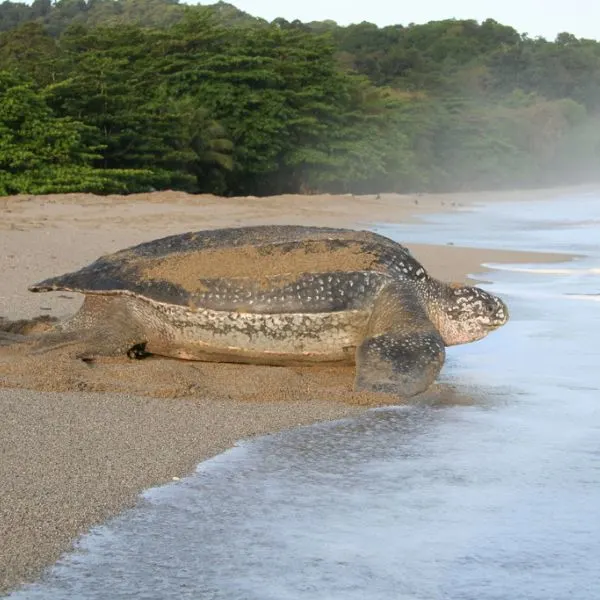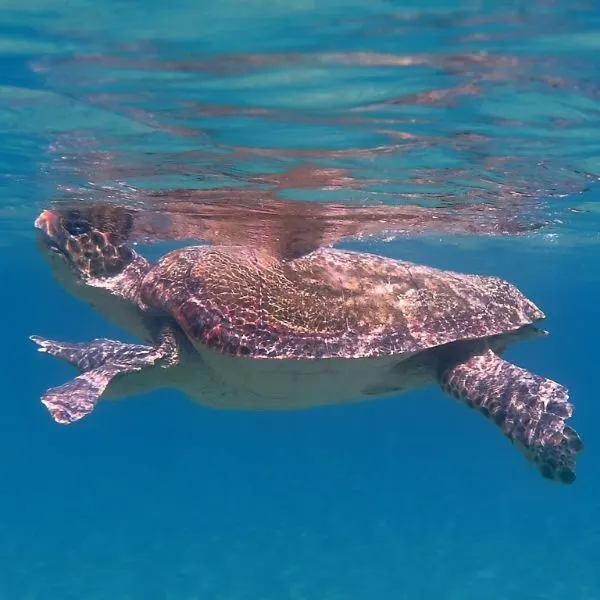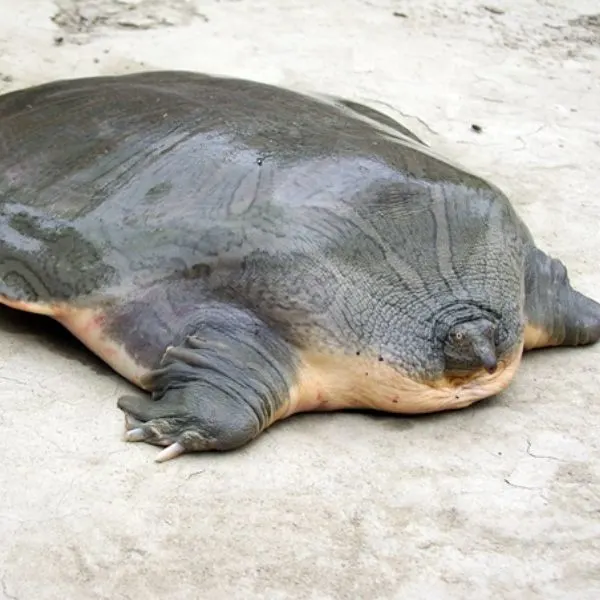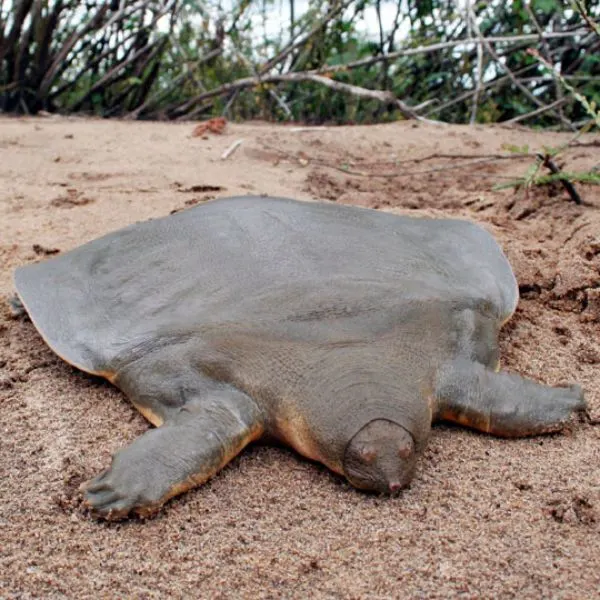The biggest turtles in the world are mostly sea turtles. The biggest turtle is the leatherback sea turtle, generally referred to simply as the leatherback.
This turtle is considered to be the largest reptile based on its weight/mass. This turtle is known to reach a weight/mass of about 1982 lb.
Other big turtles include the loggerhead turtle, the softshell turtles of the genus Chitra such as the Asian narrow-headed softshell and the Indian narrow-headed softshell, the green turtle also known as the black turtle, the alligator snapping turtle, the hawksbill turtle, the two new guinea giant softshells – the northern New Guinea giant softshell turtle and the southern New Guinea giant softshell turtle, the black softshell, and the flatback.
Table of Contents
Biggest Turtles in the World
1. Leatherback Sea Turtle

- Family: Dermochelyidae
- Scientific Name: Dermochelys coriacea
- Average Adult Carapace Length: 57 to 63 inches (145 to 160 cm)
- Adult Mass: 551 to 1982 lb (250 to 900 kg)
- Lifespan: 30 to 50+ years
- IUCN Red List Status: Vulnerable
Dermochelys coriacea is considered the biggest turtle in the world.
This turtle is also known as the luth, lute turtle, or even the leathery turtle. D. coriacea derives its common name from the lack of a hard shell. Instead, its shell is leathery. D. coriacea is the only sea turtle with a leathery carapace.
D. coriacea is widely considered the largest turtle in the world and one of the largest reptiles as well. Specimens have been known to reach a span (tip of one front flipper to the tip of the other from flipper) of 8.9 ft or 2.7 m and a carapace length of 7 ft or 2.13 m.
They are also known to be able to reach a mass of 1982 lb or 900 kg.
D. coriacea is considered to have the most fluid dynamic shape of any sea turtle (teardrop). Similar to all the other sea turtles, D. coriacea has flippers for limbs.
These are well-adapted for open sea swimming. D. coriacea lacks any claws.
D. coriacea is the only turtle that can be found as far north as Alaska. This species can all be found as far south as New Zealand. D. coriacea is endemic to all subtropical and tropical oceans and is even found in the Arctic Circle.
These turtles are able to feed in cold waters because of adaptations including an insulating layer of fat underneath the skin and blood vessels that ensure the turtle doesn’t lose body heat.
2. Loggerhead Turtle

- Family: Cheloniidae
- Scientific Name: Caretta caretta
- Length: 33 to 39 inches (85 to 100 cm)
- Mass: 170 to 1200 lb (77 to 545 kg)
- Lifespan: 62 years
- IUCN Red List Status: Vulnerable
Caretta caretta is the largest hard-shelled marine turtle.
Although the leatherback is the largest marine turtle it has a soft shell. The loggerhead is one of the largest turtles in the world with only the leatherback being large.
C. caretta can be found in tropical, subtropical, and temperate oceans of the world although they are most commonly in subtropical and temperate regions. These include the Pacific Ocean, Atlantic Ocean, and Indian Ocean.
C. caretta can be recognized by their huge heads and powerful jaws. The carapace is heart-shaped and usually has barnacles on it. The carapace is also covered in algae.
Underneath the algae and barnacles is a brownish carapace. The plastron on the other hand is cream or yellowish in coloration. The skin of males is brownish and the heads are more yellowish.
Females have more orangish skin and their heads are less yellow.
A carapace length of 39 inches is common. C. caretta can reach a mass of 1200 lb or 545 kg. As you can see, these are huge chelonians.
C. caretta lives for 30 to 62 years in the wild.
3. Asian Narrow-headed Softshell

- Family: Trionychidae
- Scientific Name: Chitra chitra
- Adult Length: 59 inches (150 cm)
- Adult Mass: 220 to 560 lbs (100 to 254 kg)
- Conservation Status: Critically Endangered
Chitra chitra is a critically endangered turtle with very few individuals remaining on earth. This rare chelonian is sometimes known as the Nutaphand’s narrow-headed softshell.
C. chitra is one of the largest turtles in the world. While it may not be a marine turtle, it is still huge. As a softshell, C. chitra can be found in the family Trionychidae.
C. chitra can reach an adult carapace length of 59 inches or 150 cm and a weight of 560 lbs or 254 kg. As you can see, this is larger than most other marine turtles. The species are tan to black in coloration with a narrow head and neck.
The species can be found in western Thailand specifically in the Mae Nam Pachi and Mae Klong drainage systems. In Java, they can be found in the Brantas River, the Ciliwung River, and the Solo river. In Malaysia, they can be found in the Pahang River.
C. chitra can be found almost exclusively in large rivers with clear water and sandy bottoms although a subpopulation in the Ciliwung River system can be found in rivers with muddy substrates and unclear waters.
4. Indian Narrow-headed Softshell Turtle

- Family: Trionychidae
- Scientific Name: Chitra indica
- Adult Length: 43 inches ( 110 cm)
- Maximum Adult Mass: 551 lbs (250 kg)
- IUCN Red List Status: Endangered
Another huge softshell turtle is C. indica. This is another softshell.
The softshells of Asia can reach massive sizes. As you may have already guessed, this chelonian is endemic to India.
Not only in India, but they can also be found in Bangladesh, Pakistan, Nepal, western Malaysia, and Myanmar. Although the geographic range of the species is large, populations are restricted and somewhat irregular.
Similar to C. chitra, C. indica can be found in large rivers with sandy substrates. Most of the day, they remain submerged in the sandy substrates of their inhabitants.
C. indica is a large softshell turtle that can usually have a carapace length of 43 inches. The carapace is olive to bluish-gray with reticulations.
The wavy reticulation pattern can also be found on the front legs as well as the neck. Similar to other softshells, C. indica has a flattened carapace which is leathery and soft to the touch.
The plastron is cream and pink. Adult females are generally larger than adult males. However, adult males have longer tails. C. indica can reach a mass of up to 551 lb.
5. Green Turtle

- Family: Cheloniidae
- Scientific Name: Chelonia mydas
- Length: 39 to 47 inches (100 to 120 cm)
- Mass: 330 to 441 lb (120 to 200 kg)
- Lifespan: 75 years
- IUCN Red List Status: Endangered
The green turtle is also known as the green sea turtle, the black turtle, or the black sea turtle.
This chelonian’s coloration is generally dark, for this reason, they are called black turtles. They are known as green turtles because of the greenish coloration of the subdermal fat of the species.
Chelonia mydas can be found in tropical and subtropical oceans of the world. These include the northern Indian Ocean, the Mediterranean Sea, the Atlantic Ocean, and the Pacific Ocean. They are generally found between the latitudes of 40 degrees south and 40 degrees north.
C. mydas prefers to live in shallow waters usually close to the coastline. Adults generally return to their natal beaches to mate. They generally migrate between their mating sites and their feeding/foraging sites.
The species are black when they are hatchlings but this coloration lightens as they grow into maturity. The carapace of C. mydas can reach a length of 47 inches or 120 cm. They can also reach a mass of 441 lb or 200 kg.
6. Alligator Snapping Turtle (Loggerhead Snapper)

- Family: Chelydridae
- Binomial Name: Macrochelys temminckii
- Average Adult Length: 14 to 32 inches (35 to 81 cm)
- Average Adult Mass: 19 to 176 lb (8.4 to 80 kg)
- Lifespan: 45 years
- IUCN Red List Status: Vulnerable
- Average Price Range: $100 to $150
Macrochelys temminckii is the largest species of the family Chelydridae which includes other snapping turtles. This is also the largest freshwater turtle in North America. M. temminckii is as aggressive as other snapping turtles are.
Wild individuals are highly aggressive especially when out of water. They also have powerful bites and have been known to bite off fingers.
M. temminckii can reach a length of 32 inches and a weight of 176 lb. They also look crocodilian with rough-looking shells and large heads with powerful jaws. Their crocodilian appearance gives them the name alligator snapping turtle.
Although M. temminckii can be aggressive and have powerful bites, they are commonly kept as pets. When kept as pets, they need a massive aquatic habitat such as a large outdoor pond.
Many captive-bred alligator snapping turtles are used to human touch and are more accommodating to humans. Regardless, these are still capable of seriously injuring their owners.
They are generally tiny when hatched, they can fit within your palm. However, within the next 5 to 10 years, they will grow to be huge.
7. Hawksbill Sea Turtle

- Family: Cheloniidae
- Scientific Name: Eretmochelys imbricata
- Adult Length: 25 to 45 inches (63 to 114 cm)
- Adult Mass: 79 to 280 lb (36 to 137 kg)
- Lifespan: 30 to 50 years
- IUCN Red List Status: Critically Endangered
E. imbricata is another marine turtle. Although there are few marine turtles, they make up about 50% of the 10 largest turtles. The hawkbill is named after its mouth/beak which resembles that of a hawk’s beak.
This turtle can reach a mass of 280 lb and a carapace length of 45 inches. Their carapace is heart-shaped like other marine turtles.
The space of their heads gives them the appearance of a hawk’s beak. Although they seem like large turtles, they are relatively smaller than the leatherback, loggerhead, and green turtle.
Males are more colorful and have a more concave plastron, thicker tails, and longer claws than females.
E. imbricata reaches sexual maturity at a much younger age when compared to other sea turtles. They reach sexual maturity at around age 3 years.
These species are believed to be capable of living to 50 years although their exact lifespan is unknown.
Similar to most other marine turtles, E. imbricata are known to migrate over large distances from their feeding/foraging sites to their mating and nesting sites.
8. New Guinea Giant Softshell Turtle

- Family: Trionychidae
- Scientific Name: Pelochelys bibroni and Pelochelys signifera
- Common Names: kiya eise (Suki), sokrere (Arammba)
- Length: 39.5 inches (100 cm)
- Mass: 260 lb (120 kg)
- IUCN Red List Status: Vulnerable
There are two New Guinea giant softshell turtles and these are the northern New Guinea giant softshell turtle (Pelochelys signifera) and the southern New Guinea giant softshell turtle (Pelochelys bibroni). Both species look very similar and are best distinguished using their geographic ranges which never overlap.
The northern New Guinea giant softshell can be found north of the New Guinea Highlands also known as the Central Range.
The range is the lowlands of northern New Guinea. The southern New Guinea giant softshell can be found south of the New Guinea Highlands.
Southern New Guinea giant softshell is known to be able to live in brackish water and has been known to swim as far as Australia although there is no subpopulation in Australia.
New Guinea giant softshells are among the largest freshwater turtles. They can reach a carapace length of 3.3 ft and a weight of 260 lb.
As with other softshells, the New Guinea giant softshell has a soft leathery carapace. The head is flat and broad.
The neck and limbs can be retracted. The species have eight digits on their front limbs and five digits on their back limbs.
9. Black Softshell Turtle

- Family: Trionychidae
- Scientific Name: Nilssonia nigricans
- Length: 35.5 inches (90 cm)
- Mass: 120 lb (54.5 kg)
- Lifespan: 100+ years
- IUCN Red List Status: Critically Endangered
Nilssonia nigricans is known as the black softshell or the Bostami turtle. This turtle is known to have a restricted geographic range.
They are known to be found in a temple pond in Chittagong in Bangladesh as well as in the Brahmaputra River. They are also found in temple ponds in Tripura and Assam.
N. nigricans is known as the black softshell because of its black coloration. The body is overall dark brown to black. Sometimes you can notice yellowish spots on the head.
They are known to reach a carapace length of 35.5 inches, although a carapace length of 31 inches or 78 cm. The species have a slightly domed carapace.
The carapace is soft instead of hard and allows for easy movement.
The species is known to reach sexual maturity when they reach a carapace length of about 16 inches or 40 cm. This length corresponds to an age of 7 to 10 years.
10. Flatback Sea Turtle

- Family: Cheloniidae
- Scientific Name: Natator depressus
- Length: 30 to 38 inches (76 to 96 cm)
- Mass: 154 lb (70 kg)
- Lifespan: 100 years
- IUCN Red List Status: Data Deficient
Also known as the Australian flatback sea turtle, this turtle can only be found in the shallow waters of Australia’s continental shelf. N. depressus is known as the flatback because the carapace of the turtle is much flatter than other sea turtles.
N. depressus has a restricted geographic range. It is found in the shallow coastal waters around northern Australia and southern New Guinea.
N. depressus can reach a carapace length of 38 inches and a weight of 198 lb. The flattened carapace is smooth.
The species’ carapace and head are gray and green or olive green in coloration. The coloration of the carapace matches that of the head. The plastron on the other hand is yellowish.
Adult females are larger and have longer tails than adult males do.
N. depressus is primarily carnivorous. It is known to feed on invertebrates such as mollusks, jellyfish, shrimp, sea cucumber, and soft corals. The species rarely feed on plants. It is known to eat seagrass.
The Australian flatback is considered vulnerable in Australia and is also considered to be the least threatened marine turtle.
Infographic about the largest turtles in the world

Frequently Asked Questions
Are big turtles legal to keep as pets?
Most big turtles have threatened species. This means that most big turtles are protected by national and international legislation to protect their wild populations. Because of this, most big turtles cannot be kept as pets.
Most of the biggest turtles in the world are sea turtles. These cannot be kept as pets as they need the open sea to survive and thrive.
They require very large spaces. Even when kept in huge aquariums such as Georgia Aquarium or Monterey Bay Aquariums they tend to have shorter lifespans.
However, some large freshwater turtles can be kept as pets. These include snapping turtles such as the common snapping turtle and the alligator snapping turtle which is one of the biggest freshwater turtles in the world.
What is the biggest turtle you can keep as a pet?
The biggest turtle you can legally keep as a pet is the alligator snapping turtle. This turtle is endemic to North America.
This large chelonian can reach a weight of 176 lb. The alligator snapping turtle is also known as the loggerhead snapper. It is so named because of its large head.
Keeping this turtle as a pet can be quite challenging because they require a huge enclosure. The initial enclosure set up for a mature individual can be expensive.
Juveniles and hatchlings may be tiny but they become huge in no time.
What is the biggest sea turtle in the world?
The biggest sea turtle is the leatherback (Dermochelys coriacea). This is also the biggest turtle in the world.
This giant can reach a weight of 1982 lb or 900 kg. This sea turtle can be found all over the world’s oceans. This turtle can even be found in arctic waters.
What is the biggest freshwater turtle in the world?
The biggest freshwater turtle in the world is certain.
The biggest freshwater turtles are the giant softshells endemic to southeastern Asia. There is little information on these softshells and the extent of their sizes has not been properly documented.
The Asian narrow-headed softshell can reach a weight of 560 lb and is considered to be one of the biggest freshwater turtles, if not the biggest. The southern New Guinea giant softshell turtle (Pelochelys bibroni) can reach a weight of 260 lb.
Conclusion
The biggest turtle in the world is the leatherback. This is a marine turtle that can reach a weight of 1982 lb.
This turtle is as heavy as some small cars. Other big sea turtles are the loggerhead, the green turtle, the hawksbill, and the flatback.
Some freshwater turtles are also huge. The alligator snapping turtle can reach a weight of 176 lb, while the narrow-headed softshells reach weights of over 500 lb.
Other large freshwater turtles include the black softshell, and the southern New Guinea giant softshell turtle (Pelochelys bibroni).
Most of the biggest turtles in the world cannot be kept as pets. However, the alligator snapping turtle can be kept as a pet.
